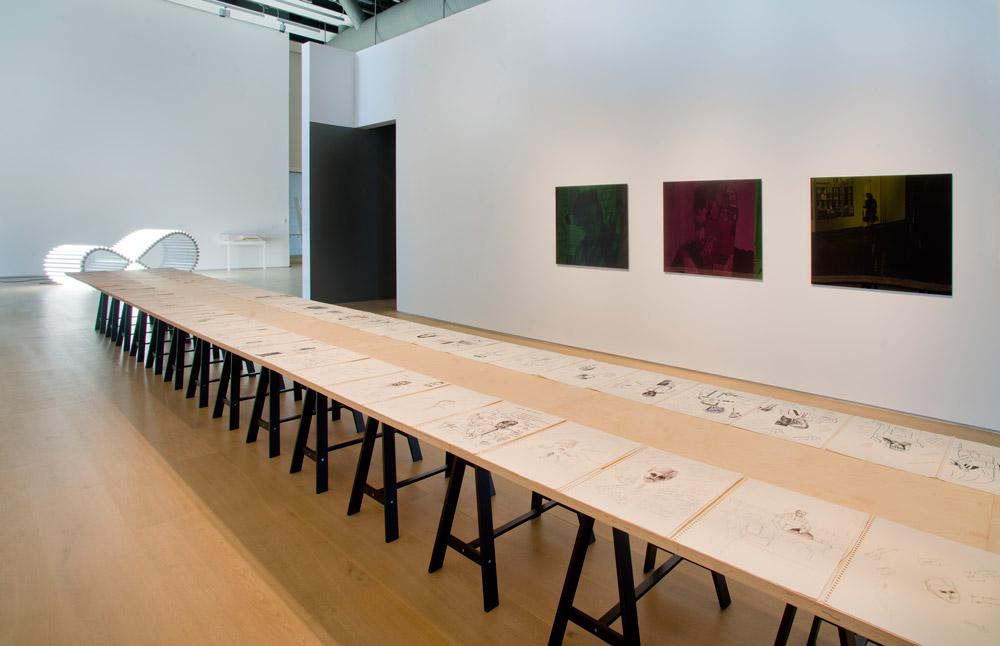“Fiction/Non-fiction” at the Esker Foundation in Calgary presents works that challenge established narratives concerning cultural and political ideologies—often through the use of historical documents and reinterpretation of their perceived validity. Featuring the work of 13 artists, the exhibition tells a story in a lateral rather than linear sense, much in the spirit of a Deleuzian understanding. Curated by Wayne Baerwaldt, Steve Loft and Naomi Potter, the exhibition coalesces three distinct curatorial voices and offers a critical space for contemplating alternative dialogues concerning narrative, fiction, reality and their convergence.
Glenn Ligon’s piece Untitled (Minnesota Massacre) (2009) critiques the commonly accepted interpretation of the titular historical event. For it, Ligon has borrowed a suite of 42 amateur paintings purchased by the Glenbow Museum in 1966. Instead of hanging the paintings, Ligon presents them mainly wrapped in plastic, resting on A-frames and pallets as if in a museum storage facility. The canvases are also partially hidden behind a false wall, so that the viewer only gains limited access to the paintings via a stairway. Peering over the wall, it is a struggle to glimpse these objects.
Another element of the Ligon work is in the exhibition space and fully accessible: a slide projector which displays snippets of text, rather than images. “The Most Thrilling Exhibition Offered to the Public” flashes across the wall, followed by blank slides. Later, “They Mounted the Scaffold that had been Erected on the Banks of the River Singing their Death Song” is revealed. The slides stitch together a disparate narrative that may or may not relate to the partially hidden canvases. Overall, Ligon’s work questions access and restriction that exists around public information, as well as the reliability of public records. His installation plays off our curiosity to seek out what we cannot access, as well as our unease at discovering underlying truths.
A 50-foot-long table covered in pen-and-ink drawings stretches down a narrow gallery. The drawings in Jeff Funnell’s Notes from the Inquest (1988) illustrate the court proceedings surrounding a fatal encounter between Wasagamack Cree leader J.J. Harper and Winnipeg police constable Robert Cross. A seemingly linear narrative emerges from the sketches, and the viewer has the distinct sense of examining archival documents that truthfully depict the proceedings. But this sense is tempered by notes scrawled throughout the image plane of each drawing; while they seem to recount witness testimonials, these notes are difficult to discern and are fragmented, evoking ambiguity.
Also included in Funnell’s installation is a document that appears to be an official judge’s report concerning the case, as well as a slow-motion video of two individuals in a fist fight. These elements further disrupt the notion of a structured, truthful narrative.
Jude Norris’s video Self-Portrait in alterNation Between Ascension & Descent (2011) disrupts a standard reading of information through the reinterpretation of a simple act. Norris is seen in what she calls “Strong Woman Dress” walking on an escalator. The mechanical sound of the escalator plays through a set of headphones; it is barely discernable, but paired with the figure’s rhythmic movements, it becomes hypnotizing. At one point, the sound and the figure’s motion changes ever so slightly, so that rather than walking downwards on an escalator moving up, she appears to be walking upwards on an escalator moving down. Norris seems locked in place between advancement and change, and we, locked with her—Norris’s gaze, fixed straight ahead, seems to latch with our own and hold us captive to her movements.
Each of the works in “Fiction/Non-fiction” calls into question normative understandings of the information available in our everyday lives, whether that information is political, cultural, social or economic. This non-linear encounter develops an ideal landscape for interrogating our acceptance of the mundane lies that often seem, through repetition or other means, to become truths.









